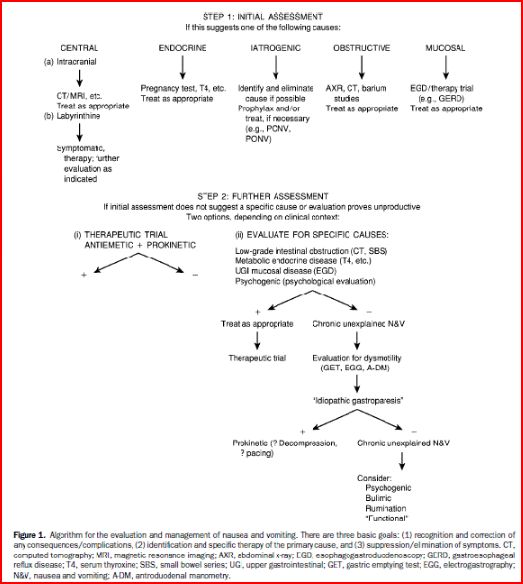Nausea and Vomiting
Discuss chronic nausea and vomiting?
Chronic nausea and vomiting is defined as symptoms persisting for more than 1 month.
Assessment of the patient with nausea and vomiting begins with differentiation of these symptoms from bulimia, regurgitation, and rumination
Discuss the causes of chronic nausea and vomiting?
- Medications like chemotherapy agents, aspirin, NSAIDS
- Infections- gastroenteritis, otitis media
- Disorders of the gut and peritoneum-
- Mechanical obstruction (Gastric outlet obstruction, small bowel obstruction)
- Functional GI disorders (gastroparesis, chronic intestinal pseudo obstruction, IBS, non ulcer dyspepsia)
- Organic GI disorders- peptic ulcer, pancreatic ca, cholecystitis, pancreatitis, hepatitis, mesenteric ischaemia, Crohn’s disease
- CNS causes- migraine, increased intracranial pressure, seizure disorders, demyelinating disorders, psychiatric disease, labyrinthine disorders
- Endocrine and metabolic disorders- pregnancy, uraemia, hypo/hyper parathyroidism, Addison’s disease, acute intermittent porphyria.
- Post operative nausea and vomiting
- Cyclic vomiting syndrome
- Miscellaneous- CCF, MI etc
Discuss the evaluation of chronic nausea and vomiting?
- Careful history
- Vomiting that occurs in the morning before breakfast is typical of that related to pregnancy, uraemia, alcohol ingestion, and increased intracranial pressure.
- Increased intracranial pressure may cause projectile vomiting and with no associated nausea. However ordinary emesis with nausea can occur too.
- The onset of vomiting caused by gastroparesis or gastric outlet obstruction tends to be delayed, usually by more than 1 hour, after meal ingestion.
- In anorexia nervosa or bulimia, vomiting typically occurs during or soon after a meal.
- Habitual postprandial or irregular vomiting is more typical of a major depression.
- The presence of CNS symptoms such as headache, vertigo, neck stiffness, and focal neurologic deficits suggests a central cause of nausea and vomiting.
- Physical examination
- Thorough examination
- Fingernails should be inspected for findings suggestive of self induced vomiting.
- Loss of dental enamel may indicate either recurrent vomiting, as in bulimia, or the consequences of gastroesophageal reflux disease.
- CNS examination- look for nystagmus, fundus and long tract signs
- Investigations guided by history and examination
Discuss the treatment of chronic nausea and vomiting?
- Labyrinthine disorders- managed by histamine H1-receptor antagonists ( have central antiemetic effects) e.g. cyclizine, cinnarizine, diphenhydramine
- Phenothiazines (prochlorperazine, chlorpromazine etc) – have significant antiemetic properties mediated through a central antidopaminergic mechanism in the area postrema. These agents are commonly used for severe episodes of nausea and vomiting, including those related to vertigo, motion sickness, and migraine.
- The butyrophenones, haloperidol and droperidol, also probably act via a central antidopaminergic effect.
- 5-HT3 antagonists (ondansetron, granisetron, tropisetron, and dolasetron). They may well operate at both central and peripheral locations. The primary site of action of these compounds is on the chemoreceptor trigger zone (area postrema)
- Benzamides- metoclopramide, domperidone
- Benzodiazepines such as lorazepam and diazepam have also been shown to be effective as adjunctive agents in the treatment of cytotoxic chemotherapy-related nausea and vomiting.
Ref








